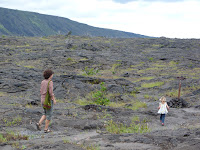 Pu'u Loa Petroglyph field is a 1.4 mile round-trip walk on the Big Island of Hawaii, and it seems perfectly fine for a little kid, especially on an overcast day, such as it was this past September when the nuclear family visited the Volcanoes National Park.
Pu'u Loa Petroglyph field is a 1.4 mile round-trip walk on the Big Island of Hawaii, and it seems perfectly fine for a little kid, especially on an overcast day, such as it was this past September when the nuclear family visited the Volcanoes National Park.
Little G Beans was eager to get out of the rental car we'd driven down the Chain of Craters Road, and my husband and I could understand how frustrating it must've been as we oohed and aahed at the amazing lava fields outside the windows while Little G, restrained by a five-point harness of a baby seat, could only swivel her head and kick her legs. Once we got out at the trailhead to Pu'u Loa, the Beans took off down the gravel and lava rock trail and didn't look back.
 |
| Goddess Pele. Painting by Herb Kane |
Talk about a unique hiking experience! We went up and down and all around lava rock, amazing looking stuff: big thick cords, softly sloping pancakes, rippled as a washboard, crunchy looking like granola. The biggest surprise is that our three-year-old loved walking it by herself, and she only fell down once. (An overcast sky and the approach of sunset helped.)
 |
| The elevated bridge above 20,000 petroglyphs |
An elevated wooden walkway rings around the main fields (and reminds me of a science fiction story—Asimov?—about visitors going back to Neolithic times and being cautioned to stay on the walkway and touch nothing, but some fool grabs at a butterfly…). Bringing a child on a hike here has a feeling like connecting the past to the present.
 |
| "Petroglyph Maker" by Herb Kane |
*
AT THE END OF THE ROAD
 |
| The end of the road. Credit: livingwilderness.com |
A quarter mile down this road (cars are made to park by a ranger's office), a relatively recent lava flow covered the way. Night was falling, so our trek across the lava was short, though a ranger passed us with a group of people carrying flashlights, for down here, a bit further on, one could actually walk to a vista point to see a red ribbon of lava gushing into the sea.
 |
| The end of the road |
*
CAMPING NEAR VOLCANO NATIONAL PARK
 |
| Highly recommended: cabins at Namakani Paio |
 |
| Inside the N.P. cabin |
Five miles from the entrance to the park is Namakani Paio Campground with both camping and cabins. The A-frame bungalows ($55/night) are awesome, private and cozy, and clean. Each has two bunks and a queen sized bed, linens and comforters (it gets chilly at night), barbecue grills, your own table and benches, and close by is a bathroom with hot showers. Keys and details are arranged directly through Volcano House, right in the park.
Other options for places to stay are
Volcano House, built in the
Victorian era on the edge of Kilauea Caldera, impressive to say the least.
Expect prices to be expensive. There is also the Kilauea Military Camp, actually a hotel and a dining hall,
available to any guest with even a thin military connection.
 |
| Pepeiao Cabin. Credit: nps.org |
Experienced hikers—probably without
children unless they are fit teenagers—have the option of various cabins in
remote areas that are accessed only after a long hike, like Pu’u’ula’ula Cabin on the Mauna Loa
Trail up the second largest mountain on the island, or Pepeiao Cabin near the sea in the Ka’u Desert Wilderness, options that are not for
beginners or little ones (yet interesting to imagine).
Kids Activities in Volcanoes Nat'l Park http://www.nps.gov/havo/forkids/index.htm
Hawai’i Volcanoes National Park www.nps.gov/havo
Hawai’i Volcanoes National Park www.nps.gov/havo
Hawai’i Pacific
Parks Association www.hawaiipacificparks.org
Friends of
Hawai’i Volcanoes National Park www.fhvnp.org
*
PHOTO ALBUM
 |
| Pu'u Loa Petroglyph hike |
 |
| How the Hawaiians survived en route to Pu'u Loa, which seem so far from food and water. |
 |
| Relaxing on ribbons of pa'hoe'hoe lava |
 |
| Snacks outside the cabin at Namakani Paio Campground |
 |
| Sea arch at the end of the road |
 |
| Lava flowed this deep across the end of the road. |

